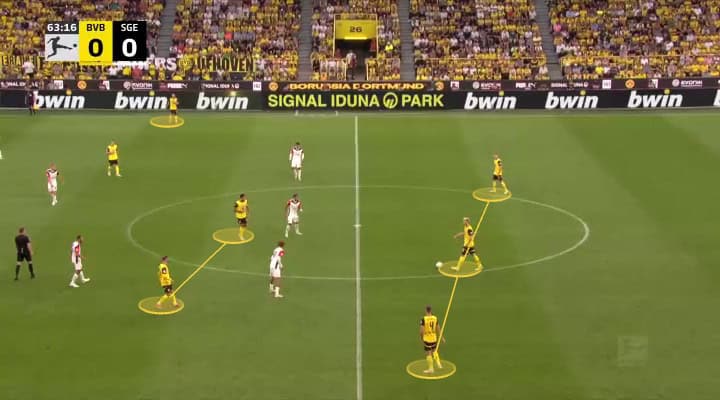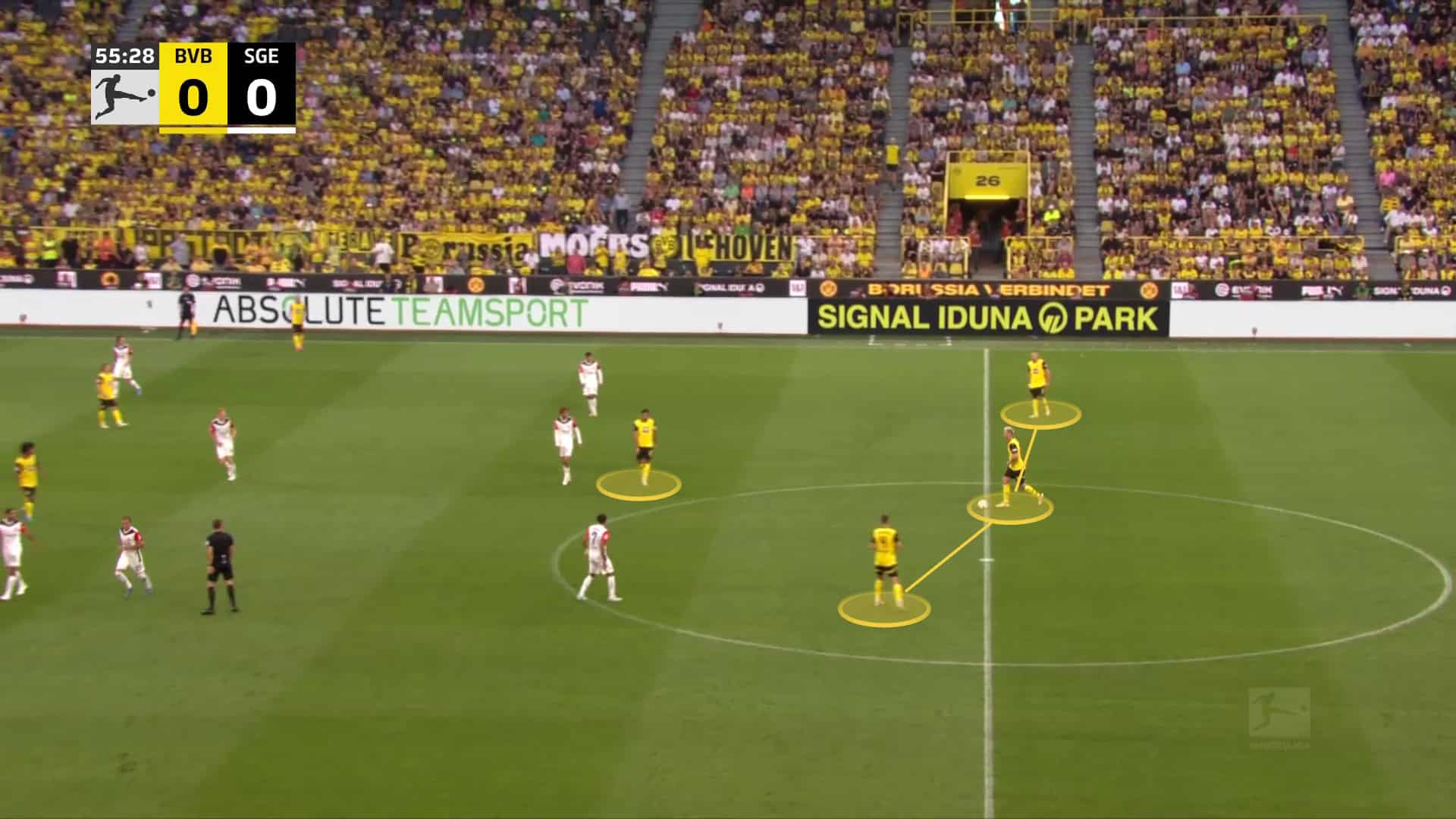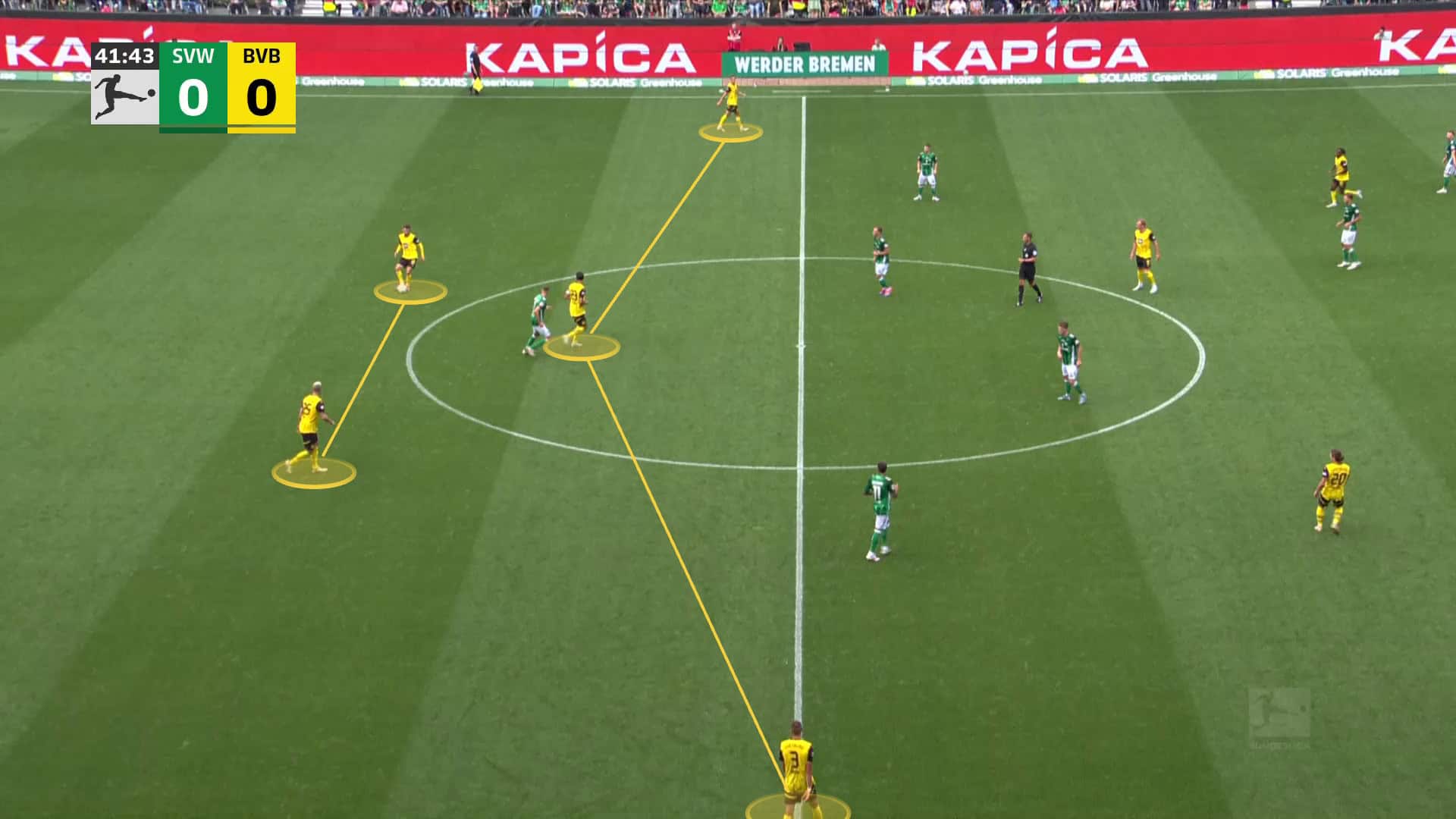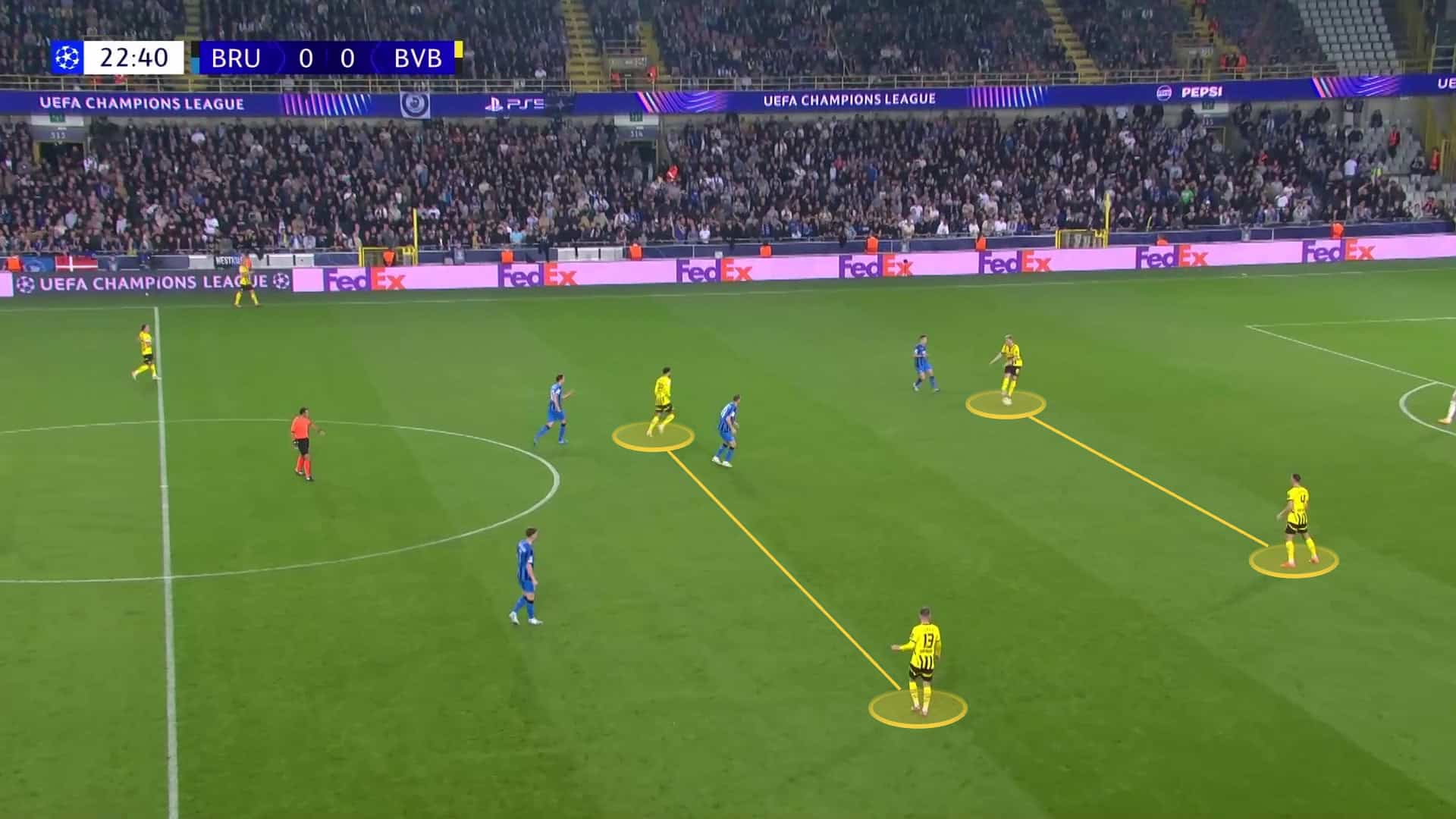Since taking over as head coach, Nuri Şahin has initiated a rapid and profound tactical transformation at Borussia Dortmund.
His vision and approach have brought an array of build-up structures and strategies to the team, allowing for flexibility and dynamism in their playing style.
In this detailed analysis, we will delve into Dortmund’s build-up play under Şahin, focusing on the different variations they employ, their effectiveness in different game situations, and what makes this approach unique.
We will also explore how these changes have impacted Dortmund’s overall style and performance, as well as how specific strategies have been tailored to exploit opponents’ weaknesses.
Nuri Şahin Tactics & Style Of Play
One of the most notable changes that Nuri Şahin’s coaching style has implemented at Dortmund is the variety of build-up structures.
These structures serve as the foundation for Dortmund’s possession play and dictate how the ball progresses from the defensive third into the attacking zones.
The most commonly seen formations are the 3-2 and 2-2 build-up structures, with adaptations based on the opposition’s pressing strategy and game circumstances.
The 3-2 Build-Up Structure
Şahin’s primary objective in the first phase of the build-up is to create numerical superiority against the opposing team’s pressing unit.
Since most Bundesliga teams typically defend in a 3-5-2 or 4-4-2 formation, Dortmund’s use of a 3-2 structure allows it to create a 3v2 advantage against the opposition’s two strikers or pressing players.
This setup ensures that Dortmund can maintain control and effectively progress the ball even when under pressure.
In this system, Dortmund often deploys three natural centre-backs to form the backline, with the left-back playing a hybrid role.
This left-back transitions between acting as a traditional left-back out of possession and as a left-sided centre-back when Dortmund is in possession.
As a result, the back three consist of the right centre-back, central centre-back, and a hybrid left centre-back/left-back.

The advantage of this 3-2 structure lies in the short passing distances between players, which facilitates quick ball circulation.
It also allows the team to be flexible in their movements, providing options to bypass the opposition’s press through a combination of short passes, line-breaking balls, and switches of play.
Moreover, the structure allows Dortmund to maintain an effective rest-defence setup, with minimal adjustments required to regain their defensive shape if possession is lost.
Adaptation To The 3-1 Build-Up Structure
As the intensity of the opponent’s press decreases, Nuri Şahin instructs his players to switch from the 3-2 build-up to a 3-1 structure.
The reasoning behind this shift is that the additional player in the double pivot becomes redundant when not facing intense pressure, and it’s more beneficial to have that player occupy a zone higher up the pitch.
The 3-1 structure offers multiple variations depending on the personnel and the game situation. For example:
One of the central midfielders drops between the left-sided centre-back and the left winger, forming an asymmetric 3-1 structure with a wide overload.
Alternatively, one of the midfielders can drop into the left-centre-back position, pushing the hybrid left-back into a more advanced wide role.

This adaptability benefits Dortmund, as BVB can adjust their build-up structure according to the game’s demands, either stretching the pitch to open up space or condensing the field to facilitate quick passing combinations.
Addressing The Opposition’s Press
Dortmund’s ability to adapt their build-up structure in response to the opponent’s pressing strategy has been one of the most impressive aspects of their tactical evolution under Şahin.
In matches where the opponents have effectively closed central spaces, such as the game against Werder Bremen, Şahin adjusted his team’s shape to create width and stretch the opposition’s defensive block.
The 2-3 Wide Build-Up
When Bremen used its 3-5-2 shape to congest the centre of the field, Dortmund struggled to progress the ball through its usual 3-2-2 structure.
Recognising this, Şahin switched to a wider 2-3 build-up structure.
In this setup, one of the central midfielders dropped deeper to form a temporary back two, while the left and right centre-backs pushed wider to occupy the flanks.
The remaining midfielder stayed central, providing a link between the defensive and midfield lines.

This adjustment aimed to stretch Bremen’s mid-block, creating gaps that Dortmund could exploit through quick ball circulation and positional rotations.
However, Dortmund’s success with this approach was limited due to the lack of attacking threat from their wider players.
Both full-backs, Ryerson and Bensebaini, were unable to capitalise on the increased space due to their limited offensive qualities, which ultimately restricted Dortmund’s ability to break down Bremen’s defence.
The 2-2 Narrow Build-Up
In other matches, such as the game against Heidenheim, Dortmund frequently utilised a 2-2 build-up structure.
This involved both full-backs pushing up high and wide, leaving the two centre-backs and two central midfielders to manage the first phase of the build-up.
The attacking midfielder occasionally dropped deeper to offer an additional passing option, further complicating Heidenheim’s efforts to disrupt Dortmund’s possession.

This approach was effective in stretching Heidenheim’s defensive lines and opening central channels for Dortmund’s attackers to exploit.
When the opponent adopted a man-oriented pressing system, Dortmund’s positional rotations and fluid movement made it difficult for them to maintain their defensive shape, allowing Dortmund to create dangerous attacking opportunities.
How The Build-Up Structures Create Scoring Opportunities
Şahin’s approach isn’t just about progressing the ball; it’s about creating optimal scoring opportunities.
By manipulating the opposition’s defensive structure through positional rotations, Dortmund has been able to open up space in dangerous areas.
For example, against Heidenheim, they often found success by using Julian Brandt’s intelligent movement.
Brandt would drift between lines, dragging defenders out of position and creating gaps for players like Guirassy, Adeyemi, and Malen to exploit.
Exploiting Width & Creating Overloads
In matches where Dortmund faced opponents with compact central defences, Şahin’s strategy of utilising wide players and creating overloads became apparent.
The full-backs or wing-backs pushed high up the pitch, pinning the opposition’s defensive line and stretching their shape horizontally.
This approach forced the opponent to make a difficult decision—either cover the wide areas, leaving gaps in the centre or stay compact, allowing Dortmund’s wide players to exploit the flanks.

Manipulating The Opponent’s Defensive Shape
Dortmund’s attacking midfielders and forwards are encouraged to make dynamic runs and positional interchanges, which disrupt the opponent’s defensive structure.
For instance, Guirassy often drops deep to link up play while Adeyemi and Malen make diagonal runs in behind the defence.
This movement confuses defenders, forcing them to choose between tracking their man or maintaining their position.
These rotations often lead to scoring chances, as Dortmund exploits the spaces created by the opponent’s indecision.
Challenges Faced
Despite the tactical progress under Nuri Şahin’s tactics, Borussia Dortmund’s build-up play is not without its challenges.
One of the main issues has been the vulnerability in rest defence, mainly when using a 2-2 or 2-3 structure.
This vulnerability arises when the full-backs push high, leaving significant spaces behind them that quick transitions from the opposition can exploit.
Dortmund’s midfielders need to be more disciplined in their positioning to cover these spaces and prevent counter-attacks.
Furthermore, the lack of offensive quality from certain wide players, like Ryerson and Bensebaini, limits Dortmund’s ability to capitalise on the wide spaces created by their build-up play.
Dortmund may need to strengthen this area through targeted signings, adding players who are more comfortable in 1v1 situations and can provide better quality in the final third.
Conclusion
Nuri Şahin’s Borussia Dortmund has displayed a sophisticated and adaptable build-up approach characterised by various structures and tactical flexibility.
This tactical evolution has shown promise, allowing Dortmund to control possession, create numerical superiority, and exploit their opponent’s weaknesses.
However, for this approach to reach its full potential, certain areas—such as defensive transitions, rest-defence, and the offensive quality of wide players—need to be addressed.
If Dortmund can continue to refine their build-up play and make key signings to strengthen their squad, they have the potential to become one of the most tactically advanced teams in the Bundesliga.
As Şahin continues implementing his philosophy, Dortmund’s fans can expect a season of exciting, possession-based football combining intelligent build-up play with dynamic attacking movements.
This tactical journey under Şahin is still in its early stages, but the signs of progress are clear, and Borussia Dortmund appears to be on a promising path under their new head coach.




Comments